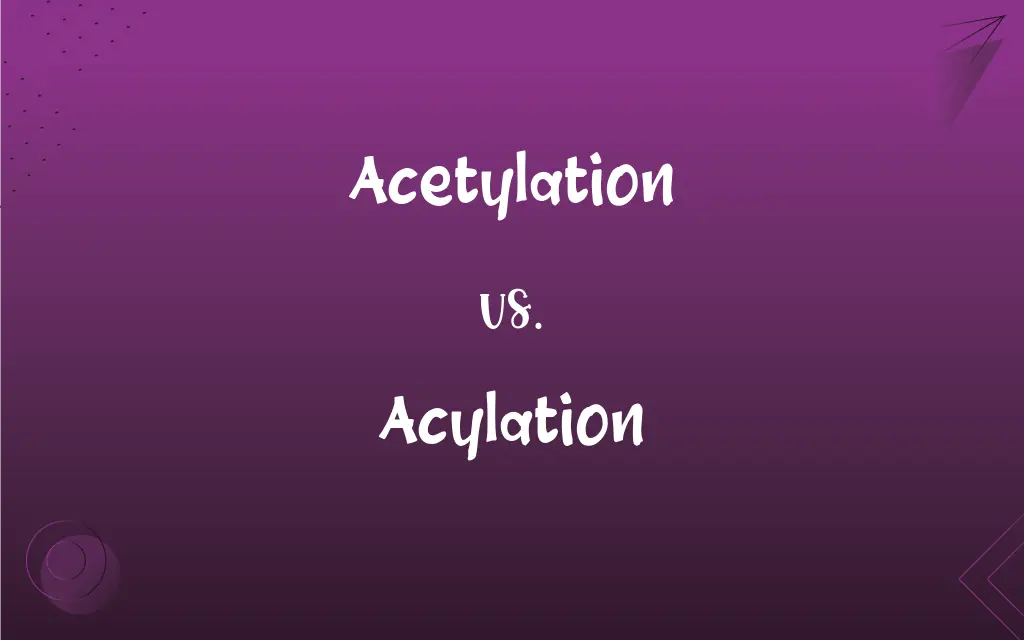Acetylation vs. Acylation: What's the Difference?
Edited by Aimie Carlson || By Harlon Moss || Published on December 7, 2023
Acetylation is the process of adding an acetyl group (CH₃CO) to a molecule, while acylation is the broader process of adding an acyl group (RCO) to a molecule, where R can be any organic group.

Key Differences
Acetylation specifically involves the addition of an acetyl group, a two-carbon unit, to another molecule. Acylation encompasses a wider range of reactions, involving the addition of various acyl groups, which can vary in the length and complexity of the carbon chain.
In biological systems, acetylation often occurs on proteins and affects their function and interaction. Acylation in biology can involve different acyl groups and can modify proteins, lipids, and other biomolecules, influencing their properties and activities.
Acetylation is commonly used in protein modification, especially histones, affecting gene expression. Acylation can also modify proteins but includes a broader range of modifications with various acyl groups, affecting cell signaling, membrane localization, and protein stability.
Chemically, acetylation typically uses acetic acid or its derivatives as the acetyl source. Acylation can involve various acid chlorides, anhydrides, or esters as sources of the acyl group, offering diverse chemical reactivity.
In industrial applications, acetylation is used to modify cellulose, creating materials like acetate fabrics. Acylation finds wider applications, including in the synthesis of pharmaceuticals, where different acyl groups are introduced to alter drug properties.
ADVERTISEMENT
Comparison Chart
Type of Group Added
Acetyl group (CH₃CO)
Acyl group (RCO), R is variable
Biological Impact
Affects protein function and gene expression
Modifies proteins, lipids, and other biomolecules
Common Applications
Protein modification, especially histones
Diverse biomolecule modifications
Chemical Sources
Acetic acid or derivatives
Various acid chlorides, anhydrides, esters
Industrial Use
Cellulose modification for acetate fabrics
Wide-ranging, including pharmaceutical synthesis
ADVERTISEMENT
Acetylation and Acylation Definitions
Acetylation
Involves transferring a two-carbon acetyl unit.
Acetylation of cellulose produces cellulose acetate.
Acylation
Broadly modifies biomolecules in living organisms.
Lipid acylation plays a role in cell signaling.
Acetylation
Addition of an acetyl group to a molecule.
Histone acetylation can activate certain genes.
Acylation
Involves diverse acyl groups with variable carbon chains.
Acylation with different acyl groups produces various compounds.
Acetylation
Affects molecular properties like solubility and reactivity.
Acetylation of a drug can improve its absorption.
Acylation
Addition of an acyl group to a molecule.
Acylation in proteins can alter their membrane localization.
Acetylation
Commonly modifies proteins in biological systems.
Enzyme acetylation can change its activity.
Acylation
Key in synthesizing pharmaceuticals with altered properties.
Drug acylation can modify its therapeutic properties.
Acetylation
Used in histone modification, impacting DNA accessibility.
Gene regulation is influenced by histone acetylation.
Acylation
Can influence molecular stability and interactions.
Protein acylation affects its stability and function.
Acetylation
To bring an acetyl group into (an organic molecule).
Acylation
(organic chemistry) The process of adding an acyl group to a compound.
Acetylation
(organic chemistry) The reaction of a substance with acetic acid or one of its derivatives; the introduction of one or more acetyl groups into a substance.
Acylation
The process of introducing an acyl group into a compound
Acetylation
The process of introducing an acetyl group into a compound;
The acetylation of cyclooxygenase-2 by aspirin
FAQs
Is acetylation reversible?
Yes, enzymes can add or remove acetyl groups, making the process reversible.
Where is acetylation commonly found?
It's often seen in biochemistry, particularly in the modification of proteins.
What is an acetyl group?
An acetyl group is a functional group with the chemical formula CH₃CO.
What's the significance of acetylation in proteins?
It can alter protein function and is key in gene regulation and expression.
Can acetylation occur on other molecules besides proteins?
Yes, it can occur on other biological molecules like DNA and histones.
What is acetylation?
Acetylation is the process of introducing an acetyl group into a compound.
What enzymes are involved in acetylation?
Acetyltransferases add acetyl groups, while deacetylases remove them.
What is acylation?
Acylation is the process of adding an acyl group to a compound.
What role does acylation play in biochemistry?
It's crucial in protein modification, impacting structure and function.
What enzymes are involved in acylation?
Acyltransferases are enzymes that add acyl groups.
Does acetylation impact drug metabolism?
Yes, it can influence the metabolism and activity of certain drugs.
How does acylation affect drug efficacy?
It can modify drug molecules, influencing their effectiveness and metabolism.
How does acetylation affect gene expression?
It changes the chromatin structure, influencing gene accessibility for transcription.
What are acyl groups?
Acyl groups are organic functional groups derived from carboxylic acids.
Are there diseases linked to acylation processes?
Yes, improper acylation is implicated in metabolic disorders and some cancers.
How does acylation differ from acetylation?
Acylation involves a broader range of acyl groups, whereas acetylation specifically involves an acetyl group.
Is acylation reversible?
Like acetylation, acylation is also a reversible process.
What diseases are associated with acetylation processes?
Abnormal acetylation is linked to cancers, neurodegenerative disorders, and other diseases.
Can acylation occur on amino acids?
Yes, acylation can modify amino acids in proteins, affecting their properties.
Can acylation be used in industrial processes?
Yes, it's used in chemical synthesis, including pharmaceuticals and polymers.
About Author
Written by
Harlon MossHarlon is a seasoned quality moderator and accomplished content writer for Difference Wiki. An alumnus of the prestigious University of California, he earned his degree in Computer Science. Leveraging his academic background, Harlon brings a meticulous and informed perspective to his work, ensuring content accuracy and excellence.
Edited by
Aimie CarlsonAimie Carlson, holding a master's degree in English literature, is a fervent English language enthusiast. She lends her writing talents to Difference Wiki, a prominent website that specializes in comparisons, offering readers insightful analyses that both captivate and inform.







































































